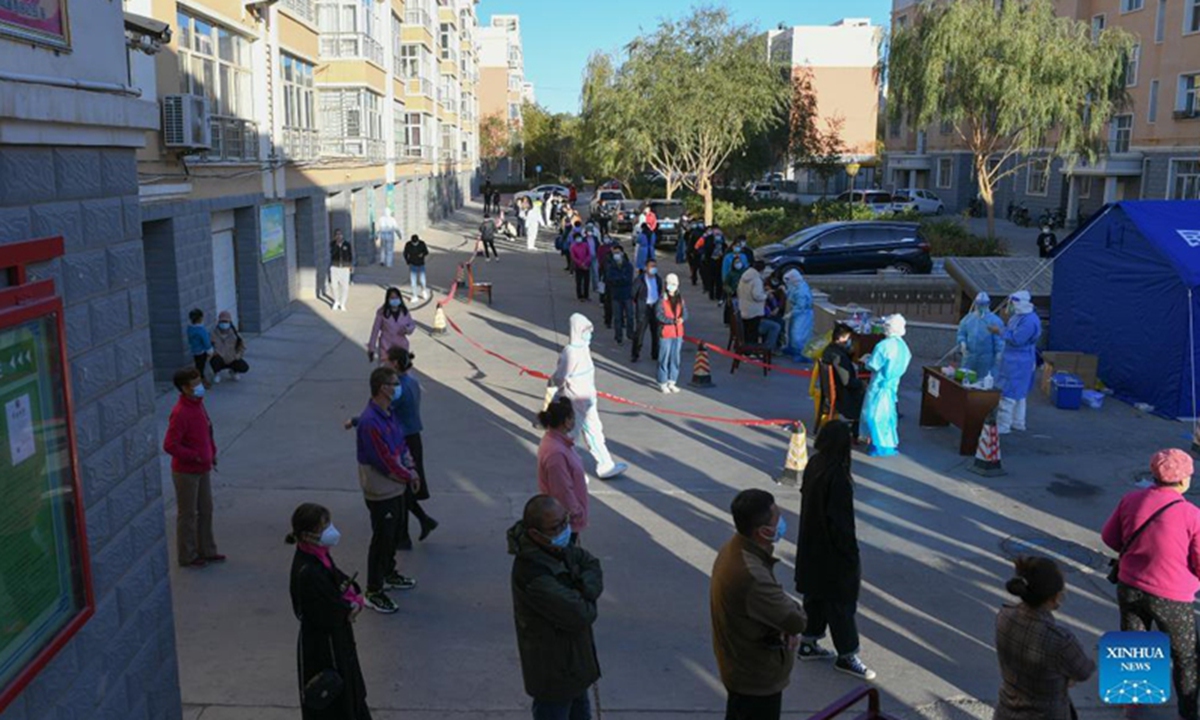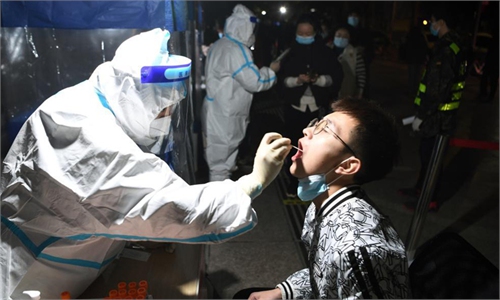
Local residents on Wednesday queue up for nucleic acid tests at a residential area in Ejina Banner of Alxa League, North China's Inner Mongolia Autonomous Region. Photo: Xinhua
A number of leading corporate-controlled Western mass media are currently belittling and attacking China's zero-COVID-19 strategy as "authoritarian" and "non-viable." Headlines like this shriek; "How long can China's zero-COVID-19 policy last?," "China's COVID-19-Zero Strategy Risks Leaving It Isolated for Years," "China is policing speech that supports 'living with Covid'." Meanwhile, the COVID-19 death of Colin Powell (who infamously set the stage for the Iraq War with a vial of powder) reminds the world to be skeptical of propaganda aimed at targeted countries.
Australia's recent abandonment of a policy similar to zero-COVID-19 exemplifies the confused and destructive approach of those who denigrate China's way. Australia has recently announced a new policy of "living with the virus." This allows for infections and deaths to occur rapidly.
It is now approaching two years since COVID-19 first appeared. In a number of countries including the US, Russia, Brazil, India and EU countries, millions continue to be infected. Large numbers are dying. The worldwide total of infected people is 243 million, with nearly 5 million deaths so far. The daily infection rates are often at or even above the levels during the previous peak times. This would seem to indicate that the pandemic will be a permanent feature of the world if the necessary policies to quell the virus are not adopted.
A careful analysis based on science and evidence ̶ and not on propaganda ̶ demonstrates that the zero-COVID-19 policy pioneered by China and a few other countries are arguably the only way to end the pandemic. To understand why this is, we need to examine China's approach in the context of the four possible approaches to the pandemic, each of which has been tried in one country or another. These approaches are: 1. herd immunity; 2. mitigation; 3. national elimination; and 4. global eradication.
Herd immunity essentially means eliminating mitigation methods or not using any of the mitigation methods to slow down or stop the virus and "letting it rip." This is increasingly the approach of a large number of countries. Even the US, Brazil or EU countries have minimized or eliminated previous mitigation methods. These include compulsory masking, social distancing, closing some but all workplaces, and shuttering schools.

A medical worker administers a booster shot of the COVID-19 vaccine to a woman at a vaccination site in Xicheng District of Beijing, capital of China, October 17.
In the US, for example, schools are now open for the fall semester and people are pushed back to work. But the infection level is around 100,000 new cases a day, equivalent to the previous peak level when schools were closed last year. Models show that approximately 150,000 more people are expected to die by the end of the year.
In countries like the US, it is being argued that if almost everyone is vaccinated, with no other protections, the virus will be stopped except for "breakthrough" infections affecting vaccinated individuals which are called "mild" and falsely presented as harmless. Such so-called mild infections among vaccinated individuals are now increasing worldwide, with 25 to 30 percent of all US infections occurring among vaccinated individuals.
In fact, research studies have found that COVID-19 cases, including mild cases, are linked to serious health damage. A large-scale study published in the authoritative British medical journal The Lancet in July this year shows that COVID-19, including "mild" cases or "serious" ones, is linked to a substantial deficit in intelligence. Individuals recovered from COVID-19 were found to have frequently lost between 10 and 1 IQ points, depending on the severity of their previous infections. Brain studies of post-COVID-19 patients reported by Harvard are also showing actual brain damage. Post-COVID-19 ongoing fatigue and tiredness have also been found to be serious common life problems. Organ damage has been reported by both Chinese and Western scientists.
Mitigation essentially means slowing down the virus spread but not extinguishing it by taking partial measures which can include closing places where people gather in groups like nightclubs and bars, closing some but not all non-essential workplaces, using facial masks, partially or wholly closing schools on a temporary basis.
The weakness of this approach is obvious: It can reduce the daily rate of new cases, but does not cut off the chain of transmission but allows for a slower but continuing spread of the virus, which then rebounds to higher infection rates when the measures are relaxed. Moreover, by allowing substantial numbers of people to continue to be infected, it provides human breeding grounds for the evolution of new and possibly even more deadly variants, like Delta.
Elimination essentially means eliminating the virus in one country. This involves ensuring that people who have the virus do not come into contacts with those who don't so that the virus has no new hosts and dies out. It entails combining mass vaccinations with temporary lockdowns of all non-essential businesses, temporary closure of all schools, and other places where the virus can be communicated.
At the same time, mass testing and tracing of anyone who has had contacts with a new carrier are carried out. As a city or area becomes virus free it must not be connected to areas where the virus is still active and the campaign to quell it is still ongoing. Cities which are cleared can then be reconnected to one another. This can only happen provided that travel restrictions or controls such as testing before travel are imposed in any city where the virus reappears.
This, of course, is precisely the method that China has used. This is why China has had 5,000 COVID-19 deaths, yet a country like the US (which tried mitigation and has now essentially opted for herd immunity) has had 700,000 COVID-19 deaths and still climbing.
Eradication essentially means eliminating the virus on a world scale, that is, in every country. It might be argued that this is impractical but there is a strong argument that this is the only way to stop the pandemic from continuing indefinitely, with the very real potential for even more infectious and deadly variants. In this approach, countries are cleared step-by-step of the virus, and movements between cleared countries and non-cleared countries (or between safe areas) are stopped or controlled.
It's worth noting that while domestic infections are virtually eliminated in China, all of the recent relatively small, sporadic outbreaks have been quelled in China. Even these were started from travelers from other infected countries and regions who brought the virus with them. Hence the argument put forward by China that COVID-19 is a world crisis and only world eradication of the pandemic can stop it.
It is high time that Western media and political leaders who seek to demonize China's zero-COVID-19 policy consider ending the mass infections, deaths, and health damage to children and adults from long ravaging COVID-19. They must think about adopting zero-COVID-19 policy to end the mayhem in their own countries.
The author is a Canadian scholar based in China. opinion@globaltimes.com.cn


